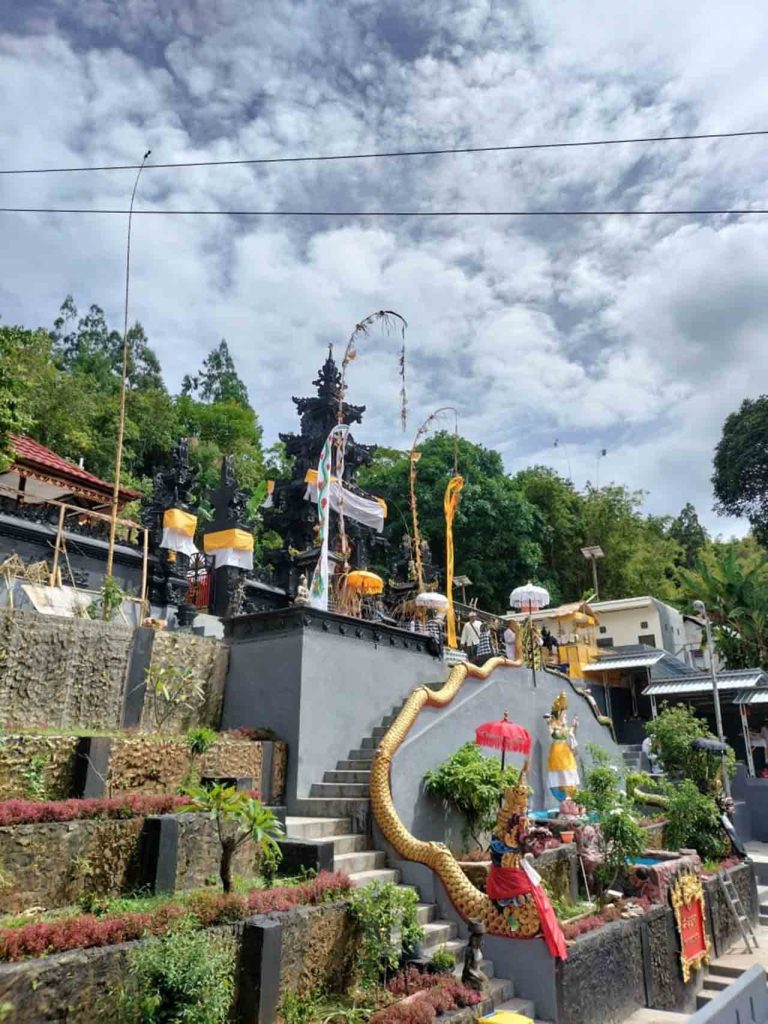Nestled in the tranquil village of Banjar Sarasada, Tampaksiring, Gianyar Regency, Mengening Temple is a historic site with deep cultural and spiritual significance. This temple is believed to have been established during the reign of King Marakata in 1022 AD.
It was first documented between 1925 and 1927 by Dutch archaeologist W.F. Stutterheim. However, it wasn’t until 1960 that historian Bernet Kempers provided a detailed account, mentioning the remnants of an ancient temple structure atop a small hill.
Subsequent excavations revealed an incomplete candi (temple) along with a lingga and yoni, which were placed in a sacred chamber, revered by the local community.
Mengening Temple is situated in the lush valley of the Pakerisan River, a location abundant with natural springs. The water from these springs is collected in a pool and flows through traditional spouts. These water sources are not only essential for Hindu religious rituals but also play a crucial role in irrigating nearby rice fields, extending even to the Pejeng and Bedulu regions. The serene atmosphere and historical significance make this site an intriguing destination for visitors.
The name “Mengening” is derived from the Balinese word meaning “clear water,” reflecting the purity of the temple’s sacred springs. According to historical records, the temple’s pristine water was traditionally used for cleansing ceremonial daggers (keris), further reinforcing its spiritual importance.
Mengening Temple is designed according to the traditional Balinese Tri Mandala concept, which divides the temple into three sections:
- Nista Mandala (Outer Courtyard)
This section serves as the entrance to the temple complex. It features a garden area dedicated to purification rituals for sacred deities. Several holy water sources (tirtha), such as Tirtha Keben, Tirtha Melela, Tirtha Megelung, Tirtha Sudamala, Tirtha Tunggang, Tirtha Soka, and Tirtha Telaga Waja, are found here and are frequently used by the local community.
- Madya Mandala (Middle Courtyard)
The central area is designated for Hindu worshippers to conduct religious activities. It includes several pavilions (bale), such as Bale Kulkul (drum tower), Bale Pegambahan (resting hall), Bale Gong (gamelan pavilion), and Bale Pegat (ceremonial hall).
- Utama Mandala (Inner Courtyard)
As the most sacred part of the temple, this area is dedicated to worship. It houses numerous shrines, including the revered Gedong Meru Tumpang Tiga, the main sanctuary for Ida Batara Prasada Agung. Other significant structures include Pelinggih Batara Gunung Kawi, Pelinggih Batara Tirta Empul, Pemaruman, Gedong Limas, Bale Saka Ulu, Bale Paselang, Bale Pecanangan, Bale Penganteb, and Pelinggih Batara Siwa.
One of the temple’s main attractions is its purification pool, which draws water from ten natural springs. Similar to the famous Tirta Empul Temple, Mengening Temple offers visitors the opportunity to participate in melukat, a traditional Balinese water purification ritual believed to cleanse negative energies, ward off illness, and bring spiritual balance. Interestingly, despite frequent use, the water in the purification pool remains crystal clear, further enhancing the temple’s mystical allure.
In accordance with Indonesian Law No. 5 of 1985, Mengening Temple was designated as a cultural heritage site due to its historical significance and archaeological value. This recognition was partly influenced by the discovery of an ancient mound within the temple grounds, which led to further research and conservation efforts.
Mengening Temple is approximately 37 kilometers from Denpasar, taking around 1 hour and 20 minutes by car. Its scenic surroundings, historical relics, and spiritual atmosphere make it a must-visit destination for those seeking both cultural enrichment and personal tranquility.
For those who appreciate history, spirituality, and the beauty of Balinese temple architecture, Mengening Temple is a hidden gem worth exploring. (BT)





